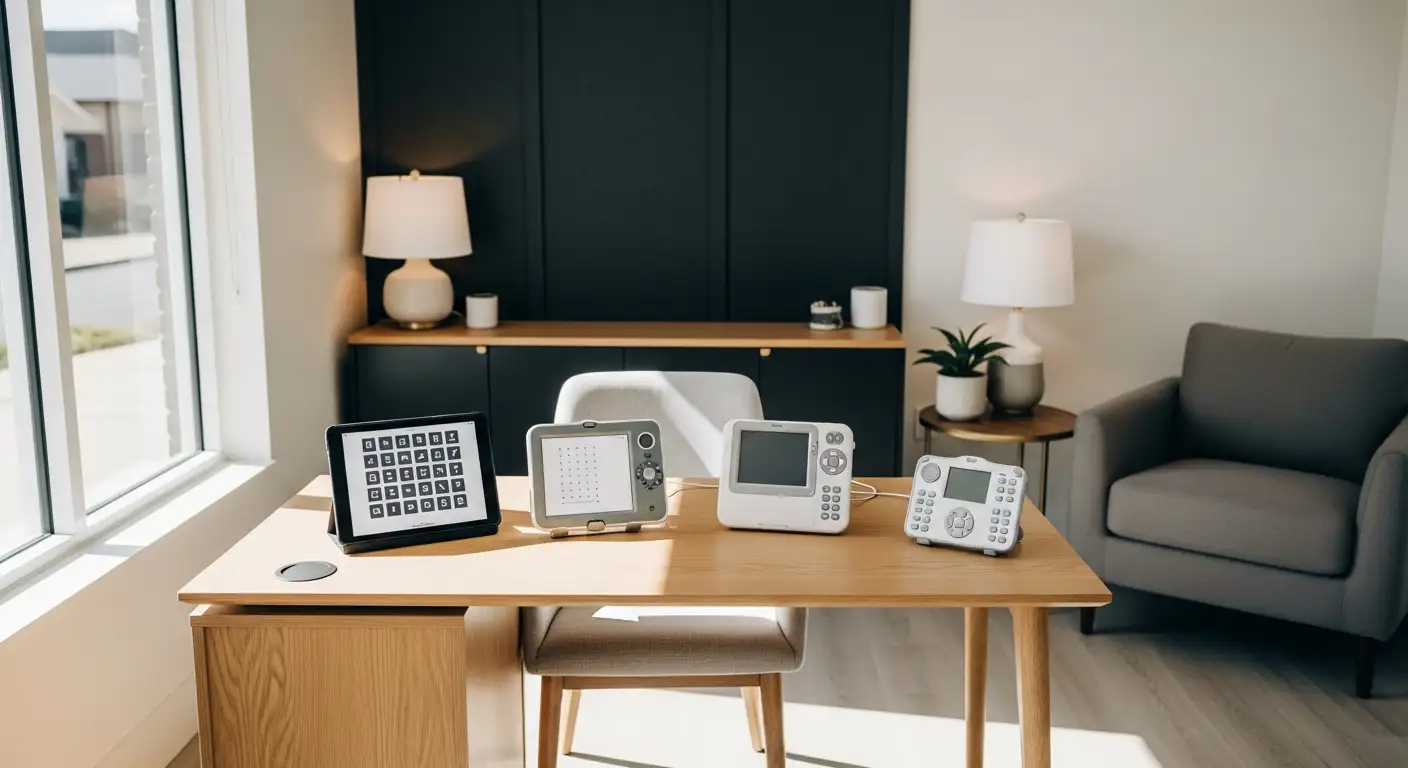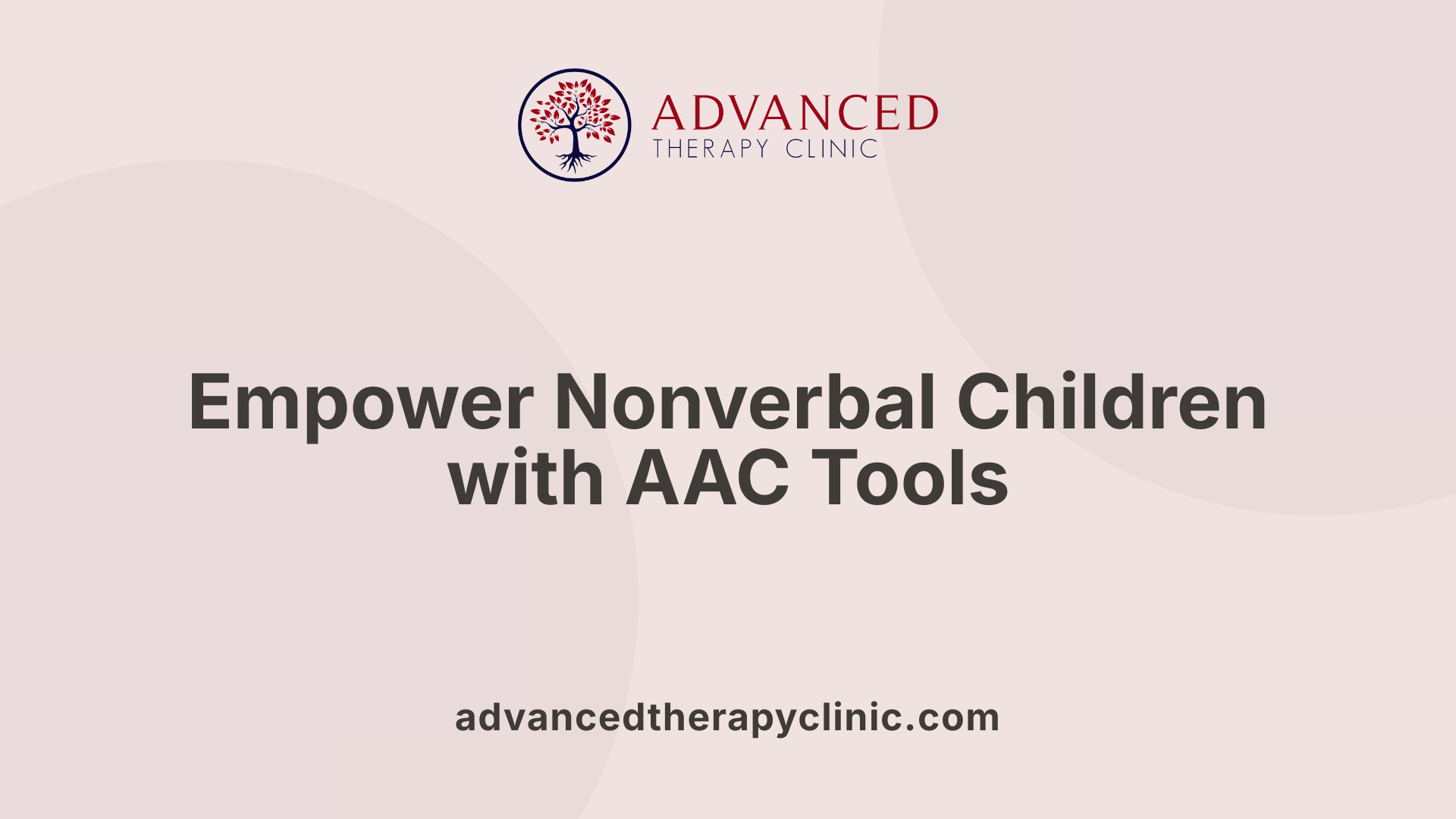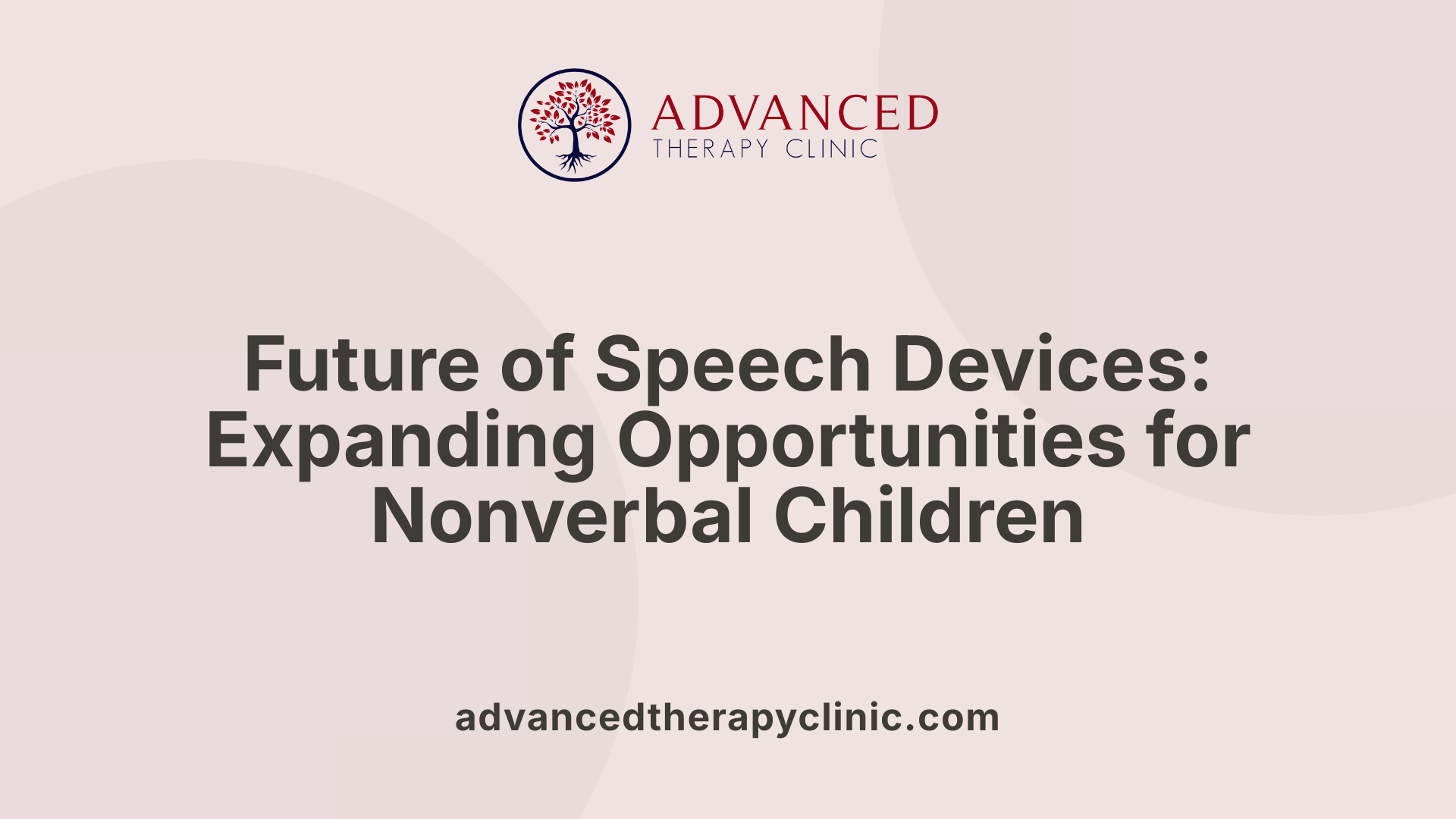How Speech Devices Enhance Communication for Nonverbal Children


Understanding the Therapy Landscape and Communication Challenges
Children with Autism Spectrum Disorder (ASD) and other developmental delays often face significant challenges in verbal communication. A variety of therapy-related fields, including speech therapy, applied behavior analysis, occupational therapy, and counseling, play crucial roles in addressing these challenges. Among these, speech therapy, supported by augmentative and alternative communication (AAC) devices, provides essential tools that empower nonverbal children to express themselves, improving their social interactions, independence, and overall quality of life.
Therapy Disciplines Supporting Communication in Nonverbal Children

What are the different therapy-related fields encompassed by the collective term for therapies?
The collective term for therapy-related fields includes various disciplines aimed at supporting individuals with disabilities and developmental challenges. These encompass applied behavior analysis (ABA) therapy, physical therapy, occupational therapy, speech therapy, counseling, and nutrition therapy. Speech therapy specifically focuses on speech-language pathology and incorporates augmentative and alternative communication (AAC) tools to assist children with speech or language impairments and nonverbal communication difficulties.
Description of key therapies supporting communication
ABA therapy is a widely accepted, evidence-based intervention for children with autism. It includes techniques like verbal behavior therapy (VBT), discrete trial training, and natural environment teaching, all tailored to improve communication skills. AAC systems, such as the Picture Exchange Communication System (PECS) and speech-generating devices (SGDs), are often integrated within these therapies to support nonverbal children.
Speech therapy involves structured interventions by licensed speech-language pathologists who use both unaided methods (gestures, body language) and aided AAC devices like picture boards, apps, and high-tech speech output devices. These therapies work in tandem to enhance language development, facilitate social interaction, and promote independence.
Role of speech therapy and related services
Speech therapy, supported by related services like AAC device implementation, plays a critical role in improving communication for children who cannot speak or have limited verbal skills. Professionals evaluate and recommend suitable AAC tools customized to each child's needs. Incorporating AAC within therapy improves expression, social participation, academic engagement, and family communication. These combined supports contribute significantly to the child's overall development and quality of life.
Augmentative and Alternative Communication (AAC): Tools for Nonverbal Children

What is AAC and What Types Exist?
Augmentative and Alternative Communication (AAC) refers to methods used to help children who cannot speak or have difficulty speaking. AAC provides various ways for these children to communicate, using either unaided or aided techniques.
What is the Difference Between Aided and Unaided AAC?
Unaided AAC involves communication without external tools, relying solely on the child's body language — such as gestures, facial expressions, and sign language. Aided AAC, on the other hand, requires external tools or devices. These can be low-tech, like picture boards and drawings, or high-tech devices, including speech-generating devices (SGDs) that produce spoken words when a child presses symbols or pictures.
What Are Some Examples of AAC Tools?
One popular AAC tool is the Picture Exchange Communication System (PECS). With PECS, children exchange pictures, drawings, or photographs to communicate their needs and desires. For example, a child might hand over a picture of a toy they want.
High-tech AAC devices include speech-generating devices or apps that turn tablets and smartphones into communication tools. Devices like TouchChat HD, Linggo Logo, and LAMP Words for Life offer customizable symbols and voice output to support communication. These apps can help children express themselves more easily and are often tailored with professional guidance from speech-language specialists.
How Do AAC Systems Support Communication for Nonverbal Children?
AAC systems bridge the communication gap by providing alternative means for children who cannot use traditional speech. By using a mix of unaided and aided methods suited to each child's needs, these systems improve their ability to express thoughts, increase social interactions, and foster independence.
| AAC Type | Description | Examples |
|---|---|---|
| Unaided AAC | Uses body language without devices | Gestures, facial expressions |
| Low-tech Aided AAC | Uses simple tools for communication | PECS, picture boards, drawings |
| High-tech Aided AAC | Employs electronic devices to generate speech | Speech-generating devices, AAC apps like TouchChat HD |
This variety ensures that children with Autism Spectrum Disorder receive personalized communication assistance enhancing their overall quality of life.
High-Tech Speech Devices: Enhancing Communication Through Innovation

What role do high-tech AAC devices play in communication for nonverbal children?
High-tech AAC devices, often called speech-generating devices (SGDs) or voice output devices, are critical tools for nonverbal children, particularly those with Autism Spectrum Disorder (ASD). These devices usually resemble tablets and use pictograms, symbols, or letters to represent words or phrases. When a user taps on an icon, the device plays a pre-recorded voice message, allowing users to express needs, thoughts, and emotions effectively.
Overview of speech-generating devices (SGDs)
Speech-generating devices range from standalone electronics to software apps designed for mobile platforms. They provide an alternative way for children who struggle with speech to communicate verbally without needing to produce spoken language themselves. This technology supports children by bridging gaps between their internal language skills and their ability to be understood by others.
Examples of tablet-based AAC apps
Several apps are designed with the unique communication needs of children with ASD in mind. Popular choices include:
- TouchChat HD with WordPower: Offers a robust vocabulary set with customizable options aiding both communication and literacy.
- Linggo Logo: Focuses on language development and motor planning.
- LAMP Words for Life: Utilizes a consistent motor pattern approach to help users develop lasting communication skills.
These apps transform smartphones or tablets into fully functional SGDs, making them portable and convenient for everyday use.
Benefits of smart devices as communication tools
Smart devices have revolutionized AAC by providing accessible and customizable communication solutions. Since many children are already comfortable with technology like tablets and smartphones, these devices seamlessly fit into their daily routines. They allow for personalization based on the child’s interests and developmental stage, facilitating stronger engagement and more natural interactions.
Additionally, smart devices increase accessibility because they are lightweight, multifunctional, and widely available. They support social interactions by enabling children to participate more fully in conversations at home, school, and in the community. This increased communication ability often leads to improved social skills, greater independence, and enhanced quality of life.
Integrating AAC with Evidence-Based Interventions: ABA Therapy and Communication Development

Role of ABA therapy in communication
Applied Behavior Analysis (ABA) therapy is a highly regarded evidence-based approach that supports children with autism in improving communication skills. ABA programs are tailored to each child's specific abilities and needs, making communication development a central goal. The therapy employs behavioral techniques such as positive reinforcement, prompting, and modeling to teach essential language and social skills.
Incorporation of AAC in ABA techniques
AAC tools like the Picture Exchange Communication System (PECS) and speech-generating devices play a vital role within ABA interventions for nonverbal children. Therapists integrate these augmentative and alternative communication methods throughout various ABA strategies, including Verbal Behavior Therapy (VBT), Natural Environment Teaching (NET), and Functional Communication Training (FCT). Using AAC during ABA sessions helps children express needs, requests, and thoughts more effectively, fostering language growth where verbal speech may be limited.
Impact on social skills and behavior
The combination of AAC and ABA techniques significantly benefits children's social interactions and behavior. Enhanced communication reduces frustration and the occurrence of challenging behaviors by providing clear ways for children to convey their intentions. As communication skills improve, children experience increased independence, stronger academic participation, and better family engagement. These positive outcomes contribute to overall boosted self-esteem and enhanced quality of life for children with Autism Spectrum Disorder.
Benefits and Future Perspectives of Speech Devices for Nonverbal Children

What are the overall benefits of using speech devices for nonverbal children?
Speech devices and AAC (augmentative and alternative communication) tools offer profound benefits for nonverbal children, especially those with Autism Spectrum Disorder. These tools enable children to effectively express their thoughts and needs, which fosters better communication and social interaction with peers and family.
By improving communication, AAC devices contribute to increased independence in daily activities and greater participation in academic settings. Beyond addressing basic communication challenges, these tools also play a crucial role in enhancing family bonding — as families can engage more fully with their child’s thoughts and emotions.
Research shows that AAC use does not impede natural speech development. Instead, it often supports and accelerates the acquisition of communication skills, enriching social engagement and inclusion. Additionally, children’s self-esteem often improves as they experience more success in interacting with others and being understood.
Healthcare coverage for high-tech AAC devices like speech-generating tablets has expanded, making these technologies more accessible to families. Simultaneously, rapid technological advancements have produced highly customizable and portable apps for smartphones and tablets. These innovations increase accessibility and ease of use, allowing AAC to be tailored to each child’s unique needs.
The future of speech devices for nonverbal children lies in ongoing integration with therapy programs and user-friendly technology. This ensures children receive personalized communication support, which fosters positive developmental outcomes, stronger family relationships, and a higher overall quality of life.
The Transformative Impact of Speech Devices on Nonverbal Communication
Speech devices and augmentative and alternative communication systems have transformed how nonverbal children engage with the world around them. By bridging the gap caused by verbal communication difficulties, these tools empower children to express their needs, desires, and emotions, resulting in improved social integration, academic participation, and independence. Supported by professional therapy disciplines and advancements in technology, AAC devices continue to evolve, offering increasingly personalized and effective communication solutions. As awareness and accessibility grow, these innovations promise a brighter future for children who once had limited means to be understood.
References
- Alternative and Augmentative Communication (AAC)
- Understanding the Power of AAC Devices for Nonverbal ...
- AAC Devices: Empowering Communication for Children With ...
- How AAC with Speech Therapy Empowers Nonverbal Kids
- How ABA Therapy Can Improve Communication Skills in ...
- Specifying Related Services in the IEP
- New York State Early Intervention Program
Recent articles

Physical Therapy Approaches for Treating Cerebral Palsy
Innovative Strategies in Cerebral Palsy Rehabilitation

The Benefits of Occupational Therapy for Enhancing Play and Leisure Skills
Unlocking Potential Through Play: How Occupational Therapy Transforms Lives

Autism Apps For Children
Harnessing Technology to Support Children with Autism

How ABA Therapy Teaches Coping Skills for Anxiety
Building Emotional Resilience in Autism Through ABA Approaches

How Autism Affects Daily Life Adults
Understanding the Complexities of Autism in Adult Daily Life

What Is Speech Sound Disorder
Understanding Speech Sound Disorders: An In-Depth Exploration


